At first, using a sewing machine may seem intimidating, but once you master its operation it becomes much simpler. Before getting started with any actual stitching, familiarize yourself with all of its various parts.
Thread your machine by passing thread through various thread guides and tension discs until the machine is ready for stitching.
Threading
Before threading your sewing machine, there are a few essential things you should keep in mind. Always switch off after raising the needle; this prevents accidental starting of your machine that could result in injury to either yourself, children or animals.
Start by loading your chosen thread onto the spool pin of your machine – most will point upward; please referring to your manual if unsure. Find out more about embroidery machine for beginners.
Once the thread is loaded, it will pass along the first thread guide which appears as a hook on top left of your machine and travel down its length, passing around counterclockwise around its hook.
After you have completed this step, it’s time to load the bobbin according to your machine’s manual. Your bobbin will then wind the bottom thread needed for stitches.
Lowering the presser foot
As a beginner, it’s essential that you learn how to adjust the pressure settings on your machine in order to use its pressure adjustment feature correctly and balance out fabric holding and feeding pressure accordingly based on fabric type and thickness. The amount of pressure necessary may differ depending on these factors.
Many machines feature diagrams or lines and arrows on them to assist with threading correctly; otherwise, referring to your manual may provide more guidance for threading correctly.
To lower the presser foot, a lever either behind or to one side of the needle assembly can be pressed. To change pressure settings, spin the regulator (typically dial) towards + for tightening pressure or towards – for looser pressure settings.
Lowering the needle
No matter your experience level with sewing machines, knowing how to lower the needle safely is an integral component of using one. Doing so prevents accidental stitching of fingers!
Locate the needle bar holding screw. Depending on your sewing machine type, this access hole may be hidden behind a plug or removable housing. Use a screwdriver to loosen it – or ask someone else to help if necessary! You could even use a flashlight!
Place the thread onto the spool pin of your sewing machine spool pin is the tall, upright stick at the top that may either go vertically (up) or horizontally, to allow for passage through it. Make sure your bobbin case is open so it can accept thread.
Lifting the presser foot
If your material doesn’t seem to move smoothly under the presser foot, it could be because its pressure is too low. Luckily, this issue can be quickly remedied by first removing the faceplate of your sewing machine before loosening its clamp screw allowing you to easily lower and raise its presser foot as necessary.
If you are having difficulties, referring to your sewing machine’s manual for guidance may help. Altering stitch length may also prove helpful.
Once you’ve loosened the clamp screw, using your finger to lower the needle to its lowest position, and move up the presser foot as soon as it’s in place, your sewing machine is now ready!
Adjusting the stitch length
Stitch length settings on a sewing machine can make the difference between smooth seams and uneven stitches, so it is essential that you understand how to adjust them when working with new fabrics or creating decorative stitches.
Stitch length is typically indicated on a dial or knob near the needle clamp screw and measured in millimeters or inches per inch.
A higher number will produce longer stitches while lower numbers will create shorter ones. While stitch length adjustment doesn’t directly affect the needle itself, it does influence how much fabric feed dogs move before making their next stitch. When used for basting stitches it is helpful to set the longest setting so they will be easy to remove later on.

